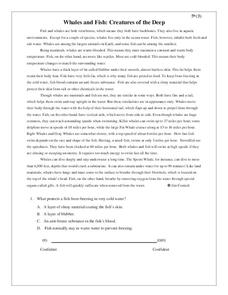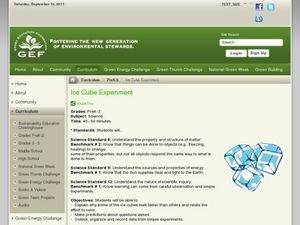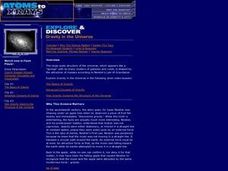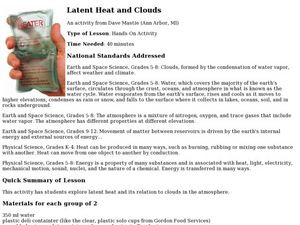Teach Engineering
An Introduction to Air Quality Research
Viewers are a PowerPoint are exposed to the idea that pollutants are in more than just the air we breathe. the presentation provides information about the layers of the earth's atmosphere and takes a look at the pollutants in the...
Curated OER
Whales and Fish: Creatures of the Deep
Practice comparing and contrasting details in informational text with a reading passage about whales. It explains the ways that fish and whales are similar, as well as the ways they are different, and specific characteristics of various...
Biology Junction
Origin of Life
Aristotle explained the idea of spontaneous generation, a concept which lasted almost 2,000 years before scientists proved it wrong. Scholars learn about the history of our understanding of the origins of life. They read examples of...
Curated OER
pH and Red Cabbage Juice
Middle schoolers review properties of materials and define what pH tells them about matter. In this pH levels lesson plan, students determine whether materials are acids or bases using indicator substances.
Curated OER
Chain Reaction
Students study animal behavior and how it changes to its environment. In this animal lesson students design and conduct experiments.
Curated OER
What's the Matter?
Students investigate matter. In this matter lesson, students identify types of matter and characteristics of each type. Students discuss matter and create matter posters to show understanding.
Curated OER
Understanding the Layers of the Earth
Fourth graders explore the three layers of the Earth describing the composition, thickness, and temperature of each layer. Layers are compared and contrasted and data unearthed placed into graphic organizers.
Curated OER
Origins: Earth is Born
Students collect and identify micrometeorites from space. Students create collection devices and retrieval methods for matter. They prepare slides and view particles found. Students discuss where the identifiable particles originated...
Curated OER
Wow, Saturn Is Much Bigger Than Earth!
Students compare and contrast the sizes of Earth and Saturn. They create scale illustrations of each planet and label them. They share their models with the class.
Curated OER
Maggie's Earth Adventures-Don't Get Caught-Solve the Next Problem, Too!
For this problem solving worksheet, students are given a series of events that occur in the Chesapeake Bay related to the rockfish. Students provide a solution to saving endangered fish and they use information/data to hypothesize why...
Curated OER
Water and Ice
Students participate in various air experiments to understand that air is all around us. In this states of matter lesson, students focus on the role of air in the water cycle. Students understand that air is densest near the ground....
Discovery Education
Motion in the Ocean
How do temperature changes affect ocean currents? Scholars explore convection currents by demonstrating the flow of water in a baking dish. They use ice, heat, and food coloring to see currents. Then, they draw conclusions about their...
Science Matters
Peanut Energy
How do humans get energy since they aren't mechanical and can't photosynthesize? Learners explore this question by relating potential energy in food to human energy levels. Scholars measure the change in mass and a change in...
Science Matters
Renewable and Nonrenewable Resources
Did you know there are at least 12 different energy sources? Scholars apply their knowledge about the different types of energy as they sort energy sources by renewable and nonrenewable. Then they pick one from each section to...
Colorado State University
What Is a "Model"?
Model the transfer of energy during a typical 24-hour period. Young scholars use a game-like approach to learning the patterns of heat transfer through the day and night. Groups of four exchange different tokens as the energy...
PHET
Mapping the Field of Multiple Dipole Magnets
So you built a magnetometer, now what? High school scientists use their magnetometer made in a previous lesson to map the union of magnetic fields of dipole magnets. They experiment with different alignments and draw conclusions about...
Biology Junction
Introduction to Biology
Welcome to Biology! Introduce pupils to a subject conceptualized by Aristotle in 300 BC through a presentation and worksheet. It covers the themes of biology, characteristics of life, the scientific method, microscopes, and measurements.
Curated OER
Fossil Fuels: Facing the Issues
Students explore energy by researching fuel usage on Earth. In this fossil fuel lesson, students define fossil fuels, the energy created by burning them, and the impact on the environment when using them. Students conduct pollution...
Curated OER
Ice Cube Experiment
Students explore the rate at which ice melts. In this science lesson, students place ice cubes on colored index cards and place them in direct sunlight. Students observe which ice cubes melt fastest and slowest.
Curated OER
Gravity In The Universe
High schoolers assess and explore gravity in the Universe via several short video lessons. They analyze why this science matters and the history of Sir Isaac Newton's law of gravity. A variety of questions are asked within this lesson...
Curated OER
Latent Heat and Clouds
Students explore latent heat and how it relates to clouds in the atmosphere. In this earth science lesson students investigate how clouds are formed. Students examine clouds and the water cycle.
Curated OER
I Don't Think We're in Kansas Anymore (Grades 2-5)
Students give examples of erosion and weathering processes. They determine causes of America's Dust Bowl phenomena.Students define erosion as the condition in which the earth's surface is worn away by the action of water and wind.
Curated OER
Physical and Chemical Changes
In this changes in matter learning exercise, students draw a picture that shows physical and chemical changes. This learning exercise has 7 fill in the blank questions.
Curated OER
Characteristics of Materials
Students describe and compare common properties of various classroom materials. For this science/matter lesson, students observe common classroom items and the materials they are made of to complete a list of common properties.























